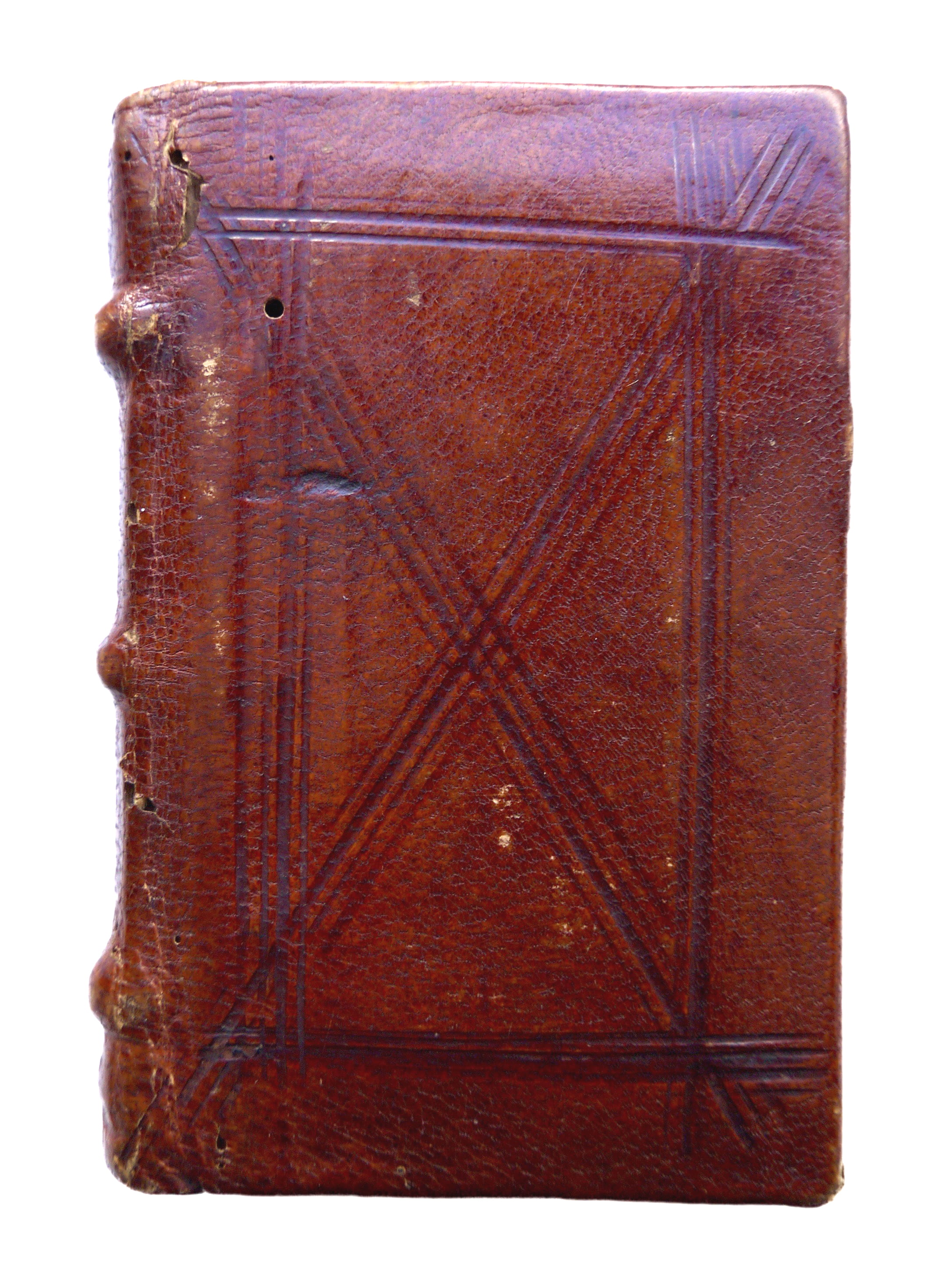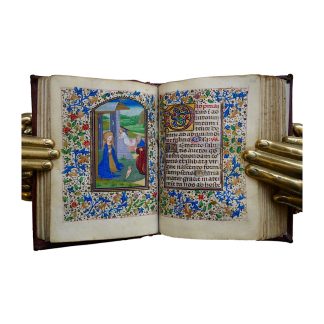BOOK OF HOURS
EXCEPTIONAL MINIATURE BOOK OF HOURS IN THE STYLE OF THE MILDMAY MASTER
Use of Rome, in Latin, illuminated manuscript on vellum
Flanders, 3rd quarter of the 15th-century, c. 1465-1475£95,000.00
Small 8vo., 96 x 68 mm, height 4 inch. 223 leaves on parchment, including 13 added leaves (fols 1, 10, 24, 48, 64, 71, 78, 85, 92, 103, 112, 124, 151), without the calendar, two leaves after fol. 17, the first added to the original collation, and some additions to the text at end; collation: I8+1, II8+2 (viii and leaf added after vii excised at the end), III6, IV8+1, V8, VI8+1, VII8, VIII8+1, IX-X8, XI8+2, XII8, XIII-XV8+1, XVI-XVII8, XVIII6, XIX8+1, XX-XXV8, XXVI8+2, XXVII4, XXVIII4-2 (iii-iv excised), traces of catchwords in lower margin of last verso of quires (see fols 49v, 94v, 102v, 145v, 167v, 175v and 183v). Justification 50 x 33 mm, ruled in purple for single vertical bounding lines and 16 horizontal lines for 15 written lines below top ruled line. Regular Gothic bookhand (Textualis Rotunda Formata) in brown and red, possibly by an Italian scribe.
Rubrics in red; versal initials (1-line high) in blue or gold with red or black penwork decoration throughout; psalm and prayers initials (2-line high) in burnished gold-leaf set against a square ground of blue and red with white tracery throughout; 13 large illuminated book-initials and full decorated borders on fols 2r, 11r, 25r, 49r, 65r, 72r, 79r, 86r, 93r, 104r, 113r, 125r and 152r: initials (5-line high) in blue or red with white tracery decoration set against burnished gold-leaf grounds infilled with ivy-leaves decoration in blue, red, purple and green highlighted with white tracery, borders decorated with acanthus and other leaves, strawberries and flowers in gold, blue, red, pink and green, gold bar framing text on left, right and lower border, reserved white ground of the borders on fols 2r and 25r with added shell-gold; 13 full-page miniatures in the style of the Mildmay Master, with double-bar and arch-topped frames in burnished gold and purple set within full decorated borders on fols 1v, 10v, 24v, 48v, 64v, 71v, 78v, 85v, 92v, 103v, 112v, 124v, 151v: borders decorated as above, with reserved white ground of borders on fols 1v and 24v with added shell-gold, miniatures illustrating the Crucifixion, Pentecost, Annunciation, Visitation, Nativity, Annunciation to the Shepherds, Adoration of the Magi, Presentation in the Temple, Massacre of the Innocents, Flight to Egypt, Coronation of the Virgin, King David in prayer and Raising of Lazarus. Good quality parchment, well preserved, margins slightly trimmed, little sign of thumbing in lower right corners. Sewn on three spine bands of double-split alum-tawed skin and with bookblock edges gilt and gauffered, late fifteenth or early sixteenth century; in brown morocco with blind-fillet decoration on thin wooden boards, re-cased probably in 16th century, newer parchment flyleaf and conjoint pastedown at the beginning and the end. In modern brown cloth box. Some worming on boards and flyleaves only.
This charming Book of Hours was produced in Bruges. These books were the result of the work of a number of different artisans and artists working separately on the different phases of production – the copying of the text, the decoration of minor initials and line fillers, and the illumination of initials, borders and miniatures.
The devotional texts were usually copied on dedicated single or multiple quires according to their length, with the beginnings of the canonical hours copied on rectos; they were then assembled in volumes whose textual sequences corresponded to the requirements of the individual customers, with dedicated miniatures inserted to face the beginning of the canonical hours and other illumination and decoration added to the clients’ taste and means.
All the illuminated miniatures of the present manuscript are on the verso of added singletons whose parchment is often heavier and thicker than the soft and beautiful parchment of the quires, which shows hardly any visible difference between the flesh and the hair side.
It is therefore unusual to find manuscripts made by the same scribe, rubricator, decorator and illuminator/s, but each of their components may find matches in different manuscripts. This manuscript shows the same textual and illustrative sequence as London, British Library, MSS Harley 1853 and Stowe 26, but for the absence of the Mass of the Virgin and perhaps of the Psalter of St Jerome at the end. The three manuscripts are also similarly diminutive. Its beautiful Italianate Gothic hand matches that of Baltimore, The Walters Art Museum MS. W. 179. The rubrication and decoration of minor initials and line-fillers is close to that of Les Enlumineures Book of Hours 61, BL Stowe MS 26, Walters MSS 190 and 196 (made for Queen Eleanor of Portugal), and the Derval Hours, Sotheby’s, 5 July 2005, lot 98 (made for Jean de Châteaugiron, seigneur de Derval and chamberlain of Brittany). The accomplished decoration of the borders finds correspondence in Les Enlumineures Book of Hours 61 and possibly Chicago, Newberry Library, Case MS. 35 (the Mildmay Hours).
The sequence of miniatures for the Hours of the Virgin corresponds to the cycle of the Infancy of Christ as was customary in Southern Flanders at the time (see B. Bousmanne, “Item a Guillaume Wyelant aussi enlumineur,” Bruxelles, 1997, p. 164). The manuscript was undoubtedly illuminated in the circle of Wilhelm Vrelant (d. 1481; active in Bruges from 1454), the most successful illuminator in Bruges at that time. His patrons included the Dukes of Burgundy and members of their family and court as well as French, Spanish, Portuguese and Italian royalty, diplomats, aristocrats, bankers and wealthy merchants.
Judging from their surviving manuscripts, he and his collaborators produced devotional books in far greater numbers than any other text; it is therefore not surprising that at the time the so-called “Vrelant style” became very popular and had a strong impact on the production of Books of Hours.
The full-page miniatures are in the style of an anonymous illuminator singled out among Vrelant’s collaborators by Nicholas Rogers and given the name of the Mildmay Master after a Book of Hours in the Newberry Library in Chicago (Case MS. 35) that in the 16th century belonged to Sir Thomas Mildmay (b. in or before 1515, d. 1566), Auditor of the Court of Augmentations for Henry VIII. The master collaborated with Vrelant in the decoration of a four-volume copy of the Golden Legend in French translation for Jean d’Auxy, knight of the Golden Fleece (New York, Pierpont Morgan Library, MSS 672-675.
A direct comparison with the Book of Hours in the British Library (Harley MS 3000) suggests that the artist working on the present manuscript is not the Mildmay Master, even though he is seemingly the same artist of a Book of Hours attributed to him in S. Hindman and A. Bergeron-Foote, An intimate Art. 12 Books of Hours for 2012, London, 2012. He is also the same artist of another devotional manuscript (Walters MS. W. 177).
The anonymous artist of these three manuscripts managed to avoid the sharp linearity and rarefied stillness that characterise the works of the Mildmay Master and used a different and warmer palette of deeper blues and reds. The iconography of his decorative cycles follows the models employed by Vrelant and his followers, but his miniatures display distinctive delicate features for the Virgin (see here the Annunciation, the Nativity and the Adoration of the Magi on fols 24v, 64v and 78v), elongated male faces (in particular of Christ on the Cross and David in prayer on fols 1v and 124v), landscapes of rolling green hills and mountains turning to dark blue in the distance, and interiors characterised by gilt-embroidered tapestries and pink and grey walls with white-stucco decoration that includes a very distinctive element.
This element recalls the monograms in the trade-mark stamps imposed on the Bruges illuminators by the town administration to stop the import of illuminated single leaves by foreign artists who were not registered with the Guild. This decorative element is particularly similar to the stamp of Adriaen de Raedt, an apprentice of Vrelant in the years 1473-1475, who was occasionally named as Vrelant in the Guild’s documents.
Almost all miniatures in the present book are a simplified version of the standardized Flemish iconography for the cycle of the Infancy of Christ disseminated by Vrelant and his followers, and found, for instance, in two Books of Hours attributed to Wilhelm Vrelant and/or associates(Walters MSS W. 196 and 197), and in the Arenberg Hours attributed to the Mildmay Master (Los Angeles, J. Paul Getty Museum, MS. Ludwig IX 8 (83.ML.104)). The fall of the idol from the column in the miniature of the Flight to Egypt (fol. 103v), in particular, is reminiscent of the Mildmay Master’s representations of the Apostle Bartolomew and Felix of Ostia destroying Idols or Mamertinus of Auxerre praying to Idols in the New York Golden Legend (PML, MS. M 675, fols 22r, 51r and 56v respectively).
The representation of the Crucifixion is the only exception. In the figures of the fore-ground and the landscape in the background our artist paraphrases the Crucifixion in Vrelant’s style as found in Walters MS. W. 197 (fol. 34v) and the Arenberg Hours (fol. 134r), but for the central scene of the Crucifixion with Christ flanked by the two thieves he seems to look elsewhere, possibly at the Crucifixion attributed to the so-called Vienna Master of Mary of Burgundy in the Hours of Mary of Burgundy (Vienna, Österreichische Nationalbibliothek, MS. 1857, fol. 99v) and the Trivulzio Hours (The Hague, Koninklijke Bibliotheek, Ms. SMCi, fol. 94v), executed about 1470-1475, which echo the Crucifixion in Joos van Ghent’s Calvary triptych of the late 1460s. A similar dating for the present manuscript is consistent with the style of the all its other features.
The volume provides no clue towards the identification of its original owner. Like many famous Bruges manuscripts such as the Spinola Hours (Los Angeles, The J. Paul Getty Museum, MS. Ludwig IX 18) and the Grimani Breviary (Venice, Biblioteca Nazionale Marciana, MS. Lat. I, 99) copied by scribes imitating Italian bookhands, or indeed by Italian scribes working in a Bruges, and decorated by Flemish artists, the present book was beautifully produced on smooth white parchment of the highest quality and copied in an elegant round Italianate Gothic hand.
The litany is of Augustinian Use, with Paul the First Hermit and Nicholas of Tolentino (canonized in 1446) among the doctors and confessors and Monica among the Virgins; other saints added to an otherwise standard text for the Use of Rome are Alexis at the end of monks and hermits, and Saints Margaret, Barbara and Elisabeth among the Virgins.
The masculine forms used in most prayers, including “Obsecro te” and “Intemerata”, with the only exception of the last, suggest that the book belonged to a man; the inclusion of the prayer “Deus propicius esto mihi peccatori et custos mei sis omnibus diebus vite mee,” traditionally attributed to St. Augustine, may indicate that he was a man of some importance, possibly a member of the large Italian community of merchants and bankers in Bruges, or a major local patron.
In stock













